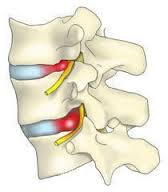 CT scanning was introduced in the 1970s and the first MRI scans were performed medically in the early 1980s. At that time it was hoped they would revolutionise the management of low back pain. Unfortunately, that didn’t happen and despite this new insight in to the painful lower back, low back pain remains the second most common reason for time off work and visits to the GP after colds and flu, and statistics suggest 80% of people will suffer low back pain during their lifetime.
CT scanning was introduced in the 1970s and the first MRI scans were performed medically in the early 1980s. At that time it was hoped they would revolutionise the management of low back pain. Unfortunately, that didn’t happen and despite this new insight in to the painful lower back, low back pain remains the second most common reason for time off work and visits to the GP after colds and flu, and statistics suggest 80% of people will suffer low back pain during their lifetime.
The intervertebral discs were commonly thought of as a major reason for pain in the lower back. This suspicion was heightened when radiological investigations started showing a prevalence of degenerative discs and disc protrusions in patients (research results show present in between 60 and 90% of those examined). That thought was maintained until researchers started performing MRI scans on asymptomatic people with startling results. In studies almost as many people who have not suffered low back pain had disc protrusions as those low back pain patients scanned clinically. Boos et al (1995) found disc protrusions in 76% of asymptomatic participants and 64% in a study by Jensen et al (1994). It is fair to conclude from this that if almost as many people who don’t have back pain have disc protrusions as those that do, then the disc protrusion alone is not the real cause of Low Back Pain.
This argument is furthered by follow up studies of low back pain patients. Research has shown that the presence or absence of disc protrusions after 10 years had no significant correlation to the patient’s outcome (Fraser at al, 1995) or how long their symptoms had persisted – Borenstein et al (2001) found that those suffering the longest duration of low back pain did not have the greatest degree of anatomical abnormality.
Interestingly, Boos et al (2000) found that a more powerful predictor of time lost from work for low back pain than abnormality on MRI imaging was physical nature of the work, job dissatisfaction and shift work.
So who is to blame? What is the real cause of ‘Low Back Pain’?
Muscles. In the spine, large muscles extend longitudinally along the length of the low back – quadratus lumborum (ribs to pelvis); psoas (lumbar spine to hips) and erector spinae (pelvis to ribs and above). When these muscles are tight they provide a compressive force in to the lumbar spine which forces the bones and discs of the lumbar spine closer together. This will cause ‘discomfort’ for a ‘healthy’ spine but if you complicate the matter by bearing down on disc protrusions, degenerative discs or joint arthritis then symptoms become greatly magnified. For me, that is the difference between a fast recovery (no underlying pathology) and patients who’s pain doesn’t resolve and end up needing the help of a physio (underlying pathology). The reason(s) for these muscles being tight is varied and one of the main focuses of my assessment – can be acute trauma, weak core stability, work postures to name a few.
My management of patients with low back pain has been significantly enhanced by Soft Tissue Release. By increased awareness of the effects of tight muscles on the human body and the ability to release them quickly has seen a remarkable reduction in patient recovery time. By stretching the tight muscles at home and strengthening the core muscles my patients at Coastal Physiotherapy are not only able to Get Better Faster but can also Stay Better Longer! This paradigm shift away from joint structures as the cause of low back pain may just see us start to reduce the prevalence and longevity of low back pain and reduce the financial stress it places on individuals and wider society.

